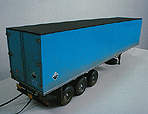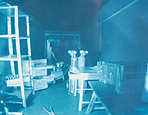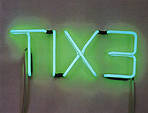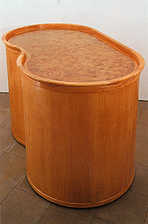
|
|
May 6, 1997
|
Art Watch Index - Apr. 29, 1997
![]()
|
<<Material Culture: the object in Britsh Art of the 1980's and 90's>>

Alison Wilding
Cornelia Parker
Gary Perkins
Cerith Wyn Evans
Damien Hirst
Grenville Davey
Sarah Lucas Photo: Hayward Gallery
White Cube: Damien Hirst http://www.whitecube. com/artists/dh.html
Hot Wired: POP | Gallery | Work by Damien Hirst
Damien Hirst Biography
Damien Hirst
Rachel Whiteread - Reference Page
Portikus Frankfurt:Sarah Lucas
White Cube: Gavin Turk
Douglas Gordon Biography
White Cube: Mona Hatoum
Mona Hatoum
MONA HATOUM
Mona Hatoum - Reference Page
Peter Greenaway
Peter Greenaway - Reference Page
White Cube: Antony Gormley
Howard Hodgkin - Reference Page
HOWARD HODGIKIN, Moonlight
Richard Hamilton
Ian Hamilton Finlay
Houston, MFA Cullen Sculpture Garden: Tony Cragg
Tony Cragg - Reference Page
Richard Deacon - Reference Page
Anish Kapoor - Reference Page
Mattress Factory Past Works: Alison Wilding
WebMuseum: Turner, Joseph Mallord William
WebMuseum: Bacon, Francis
UD Art : Francis Bacon
Gilbert & George
Gilbert & George
Gilbert and George - Reference Page
White Cube: Cerith Wyn Evans
|
On the Continuity of British Contemporary Art
Today, British art is hot? Some are saying that "now, British art is interesting". For an art critic like myself residing in the U.K., it is hard to tell how convincing such a discourse is in countries besides England. However, at least within the U.K., this perception seems to have established itself. The "Material Culture" exhibition, held at the Hayward Gallery, is an exhibition of some 70 objects created by British artists of the '80's and the '90's. The works are limited to three-dimensional works, but the names on the list of artists, such as Damien Hirst, Rachel Whiteread, Sarah Lucas, Gavin Turk, Steven Pippin, Douglas Gordon, Simon Patterson, Mona Hatoum, and Julian Opie, are those who have been leaders of the art world in the U.K. in the latter half of the '80's, and the exhibition allows us to see a panorama of the "interesting British art today". The Hayward Gallery has been aggressively engaging itself in organizing British art, by holding exhibitions like the impactful <<Spellbound>>, a Peter Greenaway installation, more recently, <<Ace>>, in which the works of the Art Council were collected, and exhibitions of artists like Antony Gormley and Howard Hodgkin who already have a stable reputation within the country. The gallery has been influential in establishing the acceptance of British contemporary art. Along with the Saatchi Gallery which has started to carry collections of British artists from the latter half of the '80's, and the Whitechapel Gallery that holds distinctive exhibitions without possessing a collection, the Hayward Gallery has become an important base for "interesting British art today". The reason why British contemporary art, which had not been actively evaluated domestically before, has become highlighted, is largely due to the contribution from the mid-sized art museums in England which have continued to intentionally take up British contemporary art since the '80's. Especially with the worldwide success of Damien Hirst, the media has been focusing on the activities of artists emerging from this generation. The continuity of British contemporary art However, it is not that British art has suddenly turned interesting from the latter half of the '80's. This exhibition seems to indicate this idea by adhering to the style of "objects". Besides the relatively young generation mentioned above, this exhibition also features works by artists who are perceived as masters, such as Richard Hamilton, John Latham, and Ian Hamilton Finlay, and artists preceding Hirst's generation, such as Tony Cragg, Richard Deacon, and Anish Kapoor. What is surprising is that the works by the young artists, who are suddenly being highlighted as "interesting" artists today, share a common attribute with the previous generation. For example, the curators of the exhibition, Michael Archer and Greg Hilty, mention in the catalogue that the works by Alison Wilding and Gavin Turk, who have entirely different characters, show a common trait in the texture of the polished metal, and this show certainly is full of such discoveries. The work of the organ of a cow in formaline by Damien Hirst, who is often considered scandolous, strangely blends in within the context of this exhibition. The works seem to relate to each other, even communicating a clear trend. This trend may be tied together as being "British-like". For example, the frequent usage of artificial materials like polished metal and plastic, an array of a type of ready-made works, and a strange cynicism towards death - all the works are cold, decisively lacking in warmth. In general, pop art is considered to be born in England and imported to the U.S., however, in British art, the "parody" often seen in American art almost cannot be seen, and everything contains a unique "irony". Each of the works look like everyday ware, and many, unless placed in an art museum, may not be recognized as artworks. This thoroughness, even in comparison with American artists from the same generation, give even a queer impression (If the formaline art by Hirst was placed in a science lab, would people consider it is a form of art? And what is the significance of this exhibition that makes such artwork inconspicuous?). The relationship between "things" in daily life and "works" of art I have always wondered why art did not develop in England. With the exception of Turner and Francis Bacon, there is hardly a time when England played a major role in the world's art history. Until the latter half of the '80's, when there was a sudden burst of interest in British art, unless one was quite strange, there probably was noone who was interested except in artists such as Gilbert & George or Richard Hamilton, who were a few of the exceptions. Perhaps this very fact was related to a certain trend which was communicated through this exhibition. British art may have been unable to become "art" because there was British art? This is probably related to the "distance" between artwork and things in daily life. My conclusion may sound like an abrupt hypothesis, but the reason why "British art is considered interesting today" is not because British art became interesting, but because the "distance" between artwork and things in daily life changed on an international level within a kind of saturated condition in the world's art scene, and as a result, their becoming similar to the trend possessed by British art. The world is becoming more British-like. If so, it may be worth reconsidering not only the recently highlighted younger generation, but also those British artists who had been holding only minor positions in art history. In that sense also, this exhibition is very valuable and worth seeing.
[Yoshitaka Mouri/Cultural Studies]
|
|
|
|
|
|
|
|
|
May 6, 1997
|
[home]/[Art Information]/[Column]
Copyright (c) Dai Nippon Printing Co., Ltd. 1997
Network Museum & Magazine Project / nmp@nt.cio.dnp.co.jp






